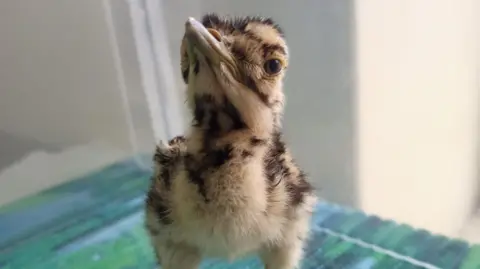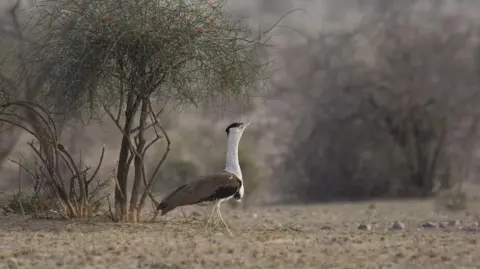 Desert National Park
Desert National ParkLast month brought good news for the great Indian bustard, a critically endangered bird found mainly in India.
Wildlife officials in the western state of Rajasthan have performed the first successful hatching of a chick through artificial insemination.
A lone adult male in one of two breeding centres in Jaisalmer city was trained to produce sperm without mating, which was then used to impregnate an adult female at the second centre some 200km (124 miles) away.
Officials said the development was important as it has opened up the possibility of creating a sperm bank.
Over the years, habitat loss, poaching and collisions with overhead power lines have effected great Indian bustards. Their numbers have fallen from more than 1,000 in the 1960s to around 150 at present.
Most of them are found in Jaisalmer and hence, conservation activists say that the bird’s habitat in the city should be protected. But this land is also prime real estate for renewable energy firms, presenting authorities with a unique conservation challenge.
 Radheshyam Pemani Bishnoi
Radheshyam Pemani BishnoiThe great Indian bustard may not be as well known as the peacock (India’s national bird) but it’s just as impressive, says Sumit Dookia, a conservation ecologist who has been studying the bird for close to a decade. The massive bird, which weighs between 15kg and 18kg, is one of the biggest flying birds in India.
It once had a prolific presence in the country and was found in at least 11 states, but today, its population is confined to Rajasthan, while a handful might be spotted in the southern state of Karnataka and the western state of Gujarat.
The shy bird plays an important role in the food chain by preying on rodents, snakes and other pests and is also the state bird of Rajasthan, where it is called ‘Godawan’ by locals.
But some of the bird’s unique evolutionary traits are clashing with human interventions, making it vulnerable to extinction.
For one, the great Indian bustard has good peripheral vision but poor frontal vision, making it difficult for them to spot power lines until they fly too close to them. Their large size makes it difficult for them to quickly change their flight path and they end up colliding with the cables and dying.
“Their vision could have developed like this as the bird spends a large amount of time on land,” says…
Click Here to Read the Full Original Article at BBC News…


